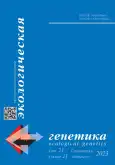Distribution of the rolB/C-like natural transgene in representatives of the genus Vaccinium L.
- Authors: Zhidkin R.R.1, Zhurbenko P.M.1,2, Matveeva T.V.1
-
Affiliations:
- Saint Petersburg State University
- Komarov Botanical Institute, Russian Academy of Sciences
- Issue: Vol 21 (2023): Спецвыпуск
- Pages: 61-62
- Section: Genetically modified organism. The Нistory, Achivements, Social and Environmental Riscs
- Submitted: 01.08.2023
- Accepted: 04.09.2023
- Published: 04.12.2023
- URL: https://journals.eco-vector.com/ecolgenet/article/view/567934
- DOI: https://doi.org/10.17816/ecogen567934
- ID: 567934
Cite item
Full Text
Abstract
Genetic colonization by agrobacteria is possible due to agrobacterial transformation, which implies interspecies transfer of genetic material (T-DNA). A transgenic tissue is formed on the whole non-transgenic plant during that process. However, it turned out that in nature there are plants containing T-DNA fragments in their genomes and they can inherit these T-DNAs sexually. Such T-DNA was called cellular, and such plants were called natural transgenic.
Examples of such organisms are plants of the genus Vaccinium. In the genomes of two species of this genus we found cT-DNA, represented by a rolB/C-like gene [1].
Previously, analyzing the natural transgenes in another genus (Camellia L.) [2], we showed the importance of reconstructing the allelic states of transgenes for phylogenetic studies. In this study, we performed analysis of the spreading of the rolB/C-like gene for its use as a molecular marker within Vaccinium.
We used molecular-genetic and bioinformatics methods for sequencing, assembly, and analysis of the rolB/C-like gene. We discovered 26 new Vaccinium species and Agapetes serpens (Wight) Sleumer as containing the rolB/C-like gene. Most of studied samples are characterized by the presence of full-size genes. This made it possible to develop approaches for alleles phasing of the rolB/C-like gene and reconstruct a Vaccinium phylogenetic relationship.
We subjected the studied species to phylogenetic analysis based on sequences of the rolB/C-like gene. The resulting phylogenetic tree of the genus Vaccinium divided the species into sections in accordance with the classical genus system based on morphological characters. At the same time, our tree did not confirm the taxa determined on the basis of ITS.
Keywords
Full Text
Genetic colonization by agrobacteria is possible due to agrobacterial transformation, which implies interspecies transfer of genetic material (T-DNA). A transgenic tissue is formed on the whole non-transgenic plant during that process. However, it turned out that in nature there are plants containing T-DNA fragments in their genomes and they can inherit these T-DNAs sexually. Such T-DNA was called cellular, and such plants were called natural transgenic.
Examples of such organisms are plants of the genus Vaccinium. In the genomes of two species of this genus we found cT-DNA, represented by a rolB/C-like gene [1].
Previously, analyzing the natural transgenes in another genus (Camellia L.) [2], we showed the importance of reconstructing the allelic states of transgenes for phylogenetic studies. In this study, we performed analysis of the spreading of the rolB/C-like gene for its use as a molecular marker within Vaccinium.
We used molecular-genetic and bioinformatics methods for sequencing, assembly, and analysis of the rolB/C-like gene. We discovered 26 new Vaccinium species and Agapetes serpens (Wight) Sleumer as containing the rolB/C-like gene. Most of studied samples are characterized by the presence of full-size genes. This made it possible to develop approaches for alleles phasing of the rolB/C-like gene and reconstruct a Vaccinium phylogenetic relationship.
We subjected the studied species to phylogenetic analysis based on sequences of the rolB/C-like gene. The resulting phylogenetic tree of the genus Vaccinium divided the species into sections in accordance with the classical genus system based on morphological characters. At the same time, our tree did not confirm the taxa determined on the basis of ITS.
About the authors
Roman R. Zhidkin
Saint Petersburg State University
Author for correspondence.
Email: st085586@student.spbu.ru
ORCID iD: 0000-0003-3002-2393
SPIN-code: 2017-9693
Postgraduate Student
Russian Federation, Saint PetersburgPeter M. Zhurbenko
Saint Petersburg State University; Komarov Botanical Institute, Russian Academy of Sciences
Email: pj_28@mail.ru
ORCID iD: 0000-0002-2102-4568
SPIN-code: 9433-1965
Researcher, Laboratory of Biosystematics and Cytology
Russian Federation, Saint Petersburg; Saint PetersburgTatiana V. Matveeva
Saint Petersburg State University
Email: radishlet@gmail.com
ORCID iD: 0000-0001-8569-6665
SPIN-code: 3877-6598
Dr. Sci. (Biol.), Professor, Department of Genetics
Russian Federation, Saint PetersburgReferences
- Matveeva T. New naturally transgenic plants: 2020 update. Bio Comm. 2021;66(1). doi: 10.21638/spbu03.2021.105
- Chen K, Zhurbenko P, Danilov L, et al Conservation of an Agrobacterium cT-DNA insert in Camellia section Thea reveals the ancient origin of tea plants from a genetically modified ancestor. Front Plant Sci. 2022;13:997762. doi: 10.3389/fpls.2022.997762
Supplementary files










